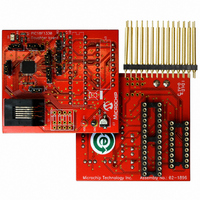AC162078 Microchip Technology, AC162078 Datasheet - Page 20

AC162078
Manufacturer Part Number
AC162078
Description
HEADER INTRFC MPLAB ICD2 18F1330
Manufacturer
Microchip Technology
Datasheet
1.AC162078.pdf
(318 pages)
Specifications of AC162078
Accessory Type
Transition Header
Lead Free Status / RoHS Status
Not applicable / Not applicable
For Use With/related Products
ICD2
Lead Free Status / RoHS Status
Lead free / RoHS Compliant, Not applicable / Not applicable
Available stocks
Company
Part Number
Manufacturer
Quantity
Price
Company:
Part Number:
AC162078
Manufacturer:
MICROCHIP
Quantity:
12 000
- Current page: 20 of 318
- Download datasheet (3Mb)
PIC18F1230/1330
2.5
Many microcontrollers have options for at least two
oscillators: a high-frequency primary oscillator and a
low-frequency
Section 3.0 “Oscillator Configurations” for details).
The oscillator circuit should be placed on the same
side of the board as the device. Place the oscillator
circuit close to the respective oscillator pins with no
more than 0.5 inch (12 mm) between the circuit
components and the pins. The load capacitors should
be placed next to the oscillator itself, on the same side
of the board.
Use a grounded copper pour around the oscillator cir-
cuit to isolate it from surrounding circuits. The
grounded copper pour should be routed directly to the
MCU ground. Do not run any signal traces or power
traces inside the ground pour. Also, if using a two-sided
board, avoid any traces on the other side of the board
where the crystal is placed.
Layout suggestions are shown in Figure 2-4. In-line
packages may be handled with a single-sided layout
that completely encompasses the oscillator pins. With
fine-pitch packages, it is not always possible to com-
pletely surround the pins and components. A suitable
solution is to tie the broken guard sections to a mirrored
ground layer. In all cases, the guard trace(s) must be
returned to ground.
In planning the application’s routing and I/O assign-
ments, ensure that adjacent port pins and other signals
in close proximity to the oscillator are benign (i.e., free
of high frequencies, short rise and fall times, and other
similar noise).
For additional information and design guidance on
oscillator circuits, please refer to these Microchip
Application Notes, available at the corporate web site
(www.microchip.com):
• AN826, “Crystal Oscillator Basics and Crystal
• AN849, “Basic PICmicro
• AN943, “Practical PICmicro
• AN949, “Making Your Oscillator Work”
2.6
Unused I/O pins should be configured as outputs and
driven to a logic low state. Alternatively, connect a 1 kΩ
to 10 kΩ resistor to V
output to logic low.
DS39758D-page 20
Selection for rfPIC™ and PICmicro
and Design”
External Oscillator Pins
Unused I/Os
secondary
SS
on unused pins and drive the
®
Oscillator Design”
®
oscillator
Oscillator Analysis
®
Devices”
(refer
to
FIGURE 2-3:
(tied to ground)
Timer1 Oscillator
Bottom Layer
Copper Pour
Oscillator
GND
Primary
Crystal
OSCO
OSCI
C1
C2
T1 Oscillator: C1
DEVICE PINS
Single-Sided and In-Line Layouts:
Fine-Pitch (Dual-Sided) Layouts:
(tied to ground)
Copper Pour
SUGGESTED PLACEMENT
OF THE OSCILLATOR
CIRCUIT
Top Layer Copper Pour
`
`
(tied to ground)
2009 Microchip Technology Inc.
`
Primary Oscillator
T1 Oscillator: C2
Crystal
DEVICE PINS
C2
C1
Oscillator
Crystal
OSC1
OSC2
GND
T1OSO
T1OS I
Related parts for AC162078
Image
Part Number
Description
Manufacturer
Datasheet
Request
R

Part Number:
Description:
Manufacturer:
Microchip Technology Inc.
Datasheet:

Part Number:
Description:
Manufacturer:
Microchip Technology Inc.
Datasheet:

Part Number:
Description:
Manufacturer:
Microchip Technology Inc.
Datasheet:

Part Number:
Description:
Manufacturer:
Microchip Technology Inc.
Datasheet:

Part Number:
Description:
Manufacturer:
Microchip Technology Inc.
Datasheet:

Part Number:
Description:
Manufacturer:
Microchip Technology Inc.
Datasheet:

Part Number:
Description:
Manufacturer:
Microchip Technology Inc.
Datasheet:

Part Number:
Description:
Manufacturer:
Microchip Technology Inc.
Datasheet:











